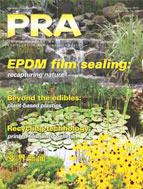 |
 |
In this Edition August 2011 |
LEAD FEATURE |
COMPANY NEWS |
MATERIALS NEWS |
MACHINERY NEWS |
INJECTION MOULDING ASIA |
PRA August 2011 Electronic Issue Now Available |
Materials News
Multi-barrier coatings for bottles
D
emands on the permeation properties of bottles are important criteria, with biopolymers or light weighting of bottles coming into the picture too. The German Institute of Plastics Processing (IKV) at RRWTH Aachen University is now looking at using PLA as a barrier coating.Having worked on the plasma coating technology for more than 20 years, IKV says besides the conception and development of processes for the interior and exterior coating of beverage bottles or coating of plastic parts, it is looking at the development of suitable layer systems to enhance the permeation properties of plasma-polymer coatings.
Currently, IKV is investigating a process to enhance the barrier performance of plasma polymer layers with the use of a substrate bias. Studies on foils already have shown that the deposition of barrier coatings using a substrate bias leads to a significant increase in the barrier properties because the negative effect of layer defects is reduced. Therefore, a plasma reactor providing the possibility to bias the inserted PET bottle has been built up recently. Studies on this new technology are currently carried out.
After a successful validation of the process a transfer to other materials such as PLA is targeted.
Besides the influence of the substrate bias on the coatings' performance its influence on the coatings' flexibility will be evaluated as well. A possible influence on the strain tolerance is crucial for applications such as carbonated soft drinks, since the occurring stress that is caused by the internal bottle pressure may lead to a stretching and even cracking of the barrier coatings. This may result in a higher permeation of gases.
For this purpose, investigations will be carried out to determine to what extent the deposition of multifunctional coatings consisting of hard and soft layers may increase the strain tolerance of the whole composite while maintaining good barrier properties at the same time.

